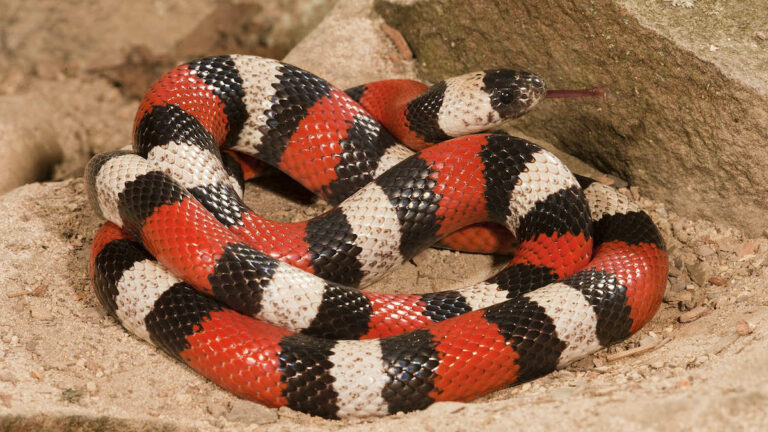The naming convention behind animals is pretty simple: if it sounds threatening, it probably is. Think about it: the Executioner wasp, the Black widow, and snakes like vipers, rattlesnakes, and cobras all sound pretty frightening. Meanwhile, snakes like garter snakes, grass snakes, and yes, milk snakes, all sound pretty cute.
Especially the Milk Snake. It almost sounds like a candy!
But then you see what the Milk Snake looks like: brightly colored with strikingly unique patterns, it almost looks like an extremely venomous reptile that can cause your premature death faster than you can cuddle it.
But good news: the Milk Snake is completely safe!
The Milk Snake: Fast Taxonomy Facts
- Kingdom: Animalia
- Subkingdom: Bilateria
- Infrakingdom: Deuterostomia
- Phylum: Chordata
- Subphylum: Vertebrata
- Infraphylum: Gnathostomata
- Superclass: Tetrapoda
- Class: Reptilia
- Order: Squamata
- Suborder: Serpentes
- Infraorder: Alethinophidia
- Family: Colubridae
- Genus: Lampropeltis
- Species: Lampropeltis triangulum
Native to the New World and predominantly found in both the North and South Americas, the Milk Snake is often confused with the much, much more dangerous coral snakes and copperheads (again with the dangerous-sounding names!). However, Milk Snakes are completely safe and pose absolutely no threat to humans; in fact, milk snakes are often bred in captivity and kept as pets.
Milk Snakes are a specific type of Kingsnake, a species of snake belonging to the genus Lampropeltis. This name is derived from the Greek language and it means “Shiny Shields”, which is appropriate: the genus features snakes that have very glossy and well-defined scales that honestly do look like shining shields on a snaky reptile.
Some scientists, however, believe that the Milk Snake should actually be split into multiple species, as there are over 20 recognized sub-species of this type. Debates rage on in the herpetology world regarding this, with the Scarlet Kingsnake, traditionally recognized as a Milk Snake sub-species, was officially recognized as a separate species back in 2006. Crazy times, indeed.
The snake’s cute name is derived from folktales that describe the snake as cheekily entering barns and milking cows, or in some variations, stealing the milk from nursing cows. In reality, of course, this is impossible because for one, snakes don’t have lips to ‘nurse’ on cows, and secondly, they can’t hold enough milk to make a difference.
The Milk Snake: Looks Can Be Deceiving

With over 20 different sub-species, the Milk Snake varies in terms of appearance and coloration, albeit with some similarities. First, all sub-species of the milk snake have banded coloration, with the bands varying in color from white, black, red, and alternating bands of different colors.
Each band is usually outlined in black, and the lighter bands are often colored in yellow, orange, or white. Most, but not all, milk snakes have light-colored Y or V shapes on their necks, which is the most telling sign that separates it from the much more dangerous coral snake.
Milk snakes are average in length, with the shortest being 14 inches, and the longest milk snakes, often found in Central and South America, can grow up to a nice 69 inches. In the United States and Canada, however, milk snakes will generally not grow above 15 inches. The length of a milk snake does not differ and is the same regardless of the snake’s gender.
In general, milk snakes have between 19 and up to 23 rows of smooth, shiny, glossy scales, with a single anal plate on its rectal area. As with most non-venomous snake, the Milk Snake has round pupils.
Milk snakes are often confused with the much more dangerous and much more lethal coral snake and, in some species, the copperhead, and for good reason: this type of mimicry is actually very common in the natural world and is an effective defensive strategy, kind of like how the Komodo dragon and the Monitor Lizard are fairly similar to each other as well.
Most animals instinctively know that snakes with bright, blotchy discolorations are venomous, which is why certain species of snakes have evolved to develop similar colorings to protect themselves and scare off would-be predators. This type of mimicry is called the Batesian mimicry, and is most common in snakes than any other animal.
However, because of this, milk snakes are often killed by humans because, surprise surprise, we confuse them with the venomous coral snake. As a form of Batesian mimicry, some species of milk snake will also shake their tails to mimic rattlesnakes, which, again, can often scare and confuse humans enough to kill them.
The Milk Snake: Meek and Mild
Generally, most species of milk snake are solitary, with most species also being primarily nocturnal when the weather is either wet or cool. However, milk snakes are also known to come out during the day. When they’re out during daytime, they can usually be found sulking under large rocks, burrowing in, well, burrows, or lounging under fallen logs. They can sometimes find their way into yards, so if your dog likes to eat grass, it might come face-to-face with a milk snake. Not that it matters, as both animals will just end up scaring each other.
During the winter, milk snakes will be in brumation, usually in communal dens. Similar to hibernation, brumation allows animals to conserve their energy by putting themselves in a semi-comatic state during the height of winter, with the only difference being that brumation allows for the snake to awake to drink water.
Be careful if you find a communal milk snake den, however, as rattlesnakes are often known to entangle themselves in milk snake dens for warmth, and because the milk snakes pose no threat to them.
In general, milk snakes are fairly docile, which is why they make for great pets. In the wild, they often avoid predators and will rarely, if at all, strike at potential threats.




